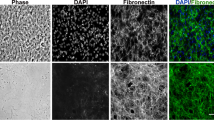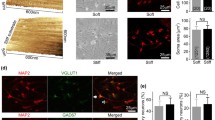Summary
Collagen substrates were characterized after preparation by the four methods most commonly used for tissue culture (saline precipitation, exposure to ammonium hydroxide vapor, exposure to ultraviolet light, and air drying). Although roughly equivalent percentages of collagen were precipitated by each technique (87 to 97%), marked differences were found in surface uniformity and ultrastructure. Substrates were quite uniform if precipitated by exposure to ammonium hydroxide or ultraviolet light, of intermediate uniformity if saline precipitated, and not at all uniform if air dried. Scanning electron microscopy revealed that (a) ammonium hydroxide and saline precipitation primarily resulted in formation of collagen fibrils, (b) air drying produced a small number of fibrils plus a large amount of amorphous material, and (c) exposure to ultraviolet light only resulted in the formation of globular, nonfibrillar collagen aggregates.
The capacity of collagen substrates to bind and grow neurons differed markedly with the method of preparation and the amount of collagen plated per unit area. Quantification of binding and growth of both cerebral and sympathetic neurons revealed that these are separate measures of the biocompatibility of a surface and that growth was uniformly inferior on globular collagen that had been precipitated by ultraviolet light. Long-term (≥2 wk) growth of sympathetic neurons was optimal on thick beds of saline-precipitated collagen, whereas short-term growth was best on thin layers of either saline or ammonium hydroxide-precipitated collagen. Cerebral neurons bound and grew optimally on thick collagen beds after both short- and long-term culture. In addition, cerebral neurons were found to be more dependent on the method of precipitation of the thin collagen substrates than were sympathetic neurons.
Similar content being viewed by others
References
Ehrmann, R. L.; Gey, G. D. The growth of cells on a transparent gel of reconstituted rat-tail collagen. J. Natl. Cancer Inst. 16:1375–1390; 1956.
Gey, G. O.; Svotelis, M.; Faord, M.; Bang, F. B. Long-term growth of chicken fibroblasts on a collagen substrate. Exp. Cell Res. 84:63–71; 1974.
Liotta, L. A.; Vembu, D.; Kleinman, K.; Marin, G. R.; Boone, C. Collagen required for proliferation of cultured connective tissue cells but not their transformed counterparts. Nature 272:622–624; 1978.
Konigsberg, I. R.; Haushka, S. D. Cell and tissue interactions in the reproduction of cell type. Locke, M. ed. Reproduction: molecular, subcellular and cellular. New York: Academic Press; 1965: 243–290.
Bernfield, M. R.; Banerjee, S. D.; Cohn, R. H. Dependence of salivary epithelial morphology and branching morphogenesis upon acid mucopolysaccharide-protein (proteoglycan) at the epithelial surface. Cell Biol. 52:674–689; 1972.
Lash J. W.; Vasan, N. S. Tissue interactions and extracellular matrix components. Lash, J. W.; Burger, M. M. eds. Cell and tissue interactions. New York: Raven Press; 1977: 101–113.
Kosher, R. A.; Church, R. L. Stimulation of in vitro somite chondrogenesis by procollagen and collagen. Nature 258:327–329; 1975.
Lash, J. W.; Vasan, N. S. Somite chondrogenesis in vitro. Dev. Biol. 66:151–171; 1978.
Hay, E. D. Interaction between the cell surface and extracellular matrix in corneal development. Lash, J. W.; Burger, M. M. eds. Cell and tissue interactions. New York: Raven Press; 1977: 115–137.
Meier, S.; Hay, E. D. Control of corneal differentiation by extracellular materials. Collagen as a promoter and stabilizer of epithelial stroma production. Dev. Biol. 38:249–270; 1974.
Bunge, R. P.; Bunge, M. B. Evidence that contact with connective tissue matrix is required for normal interaction between Schwann cells and nerve fibers. J. Cell Biol. 78:943–950; 1978.
Bornstein, M. B. Reconstituted rat-tail collagen used as substrate for tissue cultures on coverslips in Maximow slides and roller tubes. Lab. Invest. 7:134–137; 1958.
Hausbka, S. D.; Konigsberg, I. R. The influence of collagen on the development of muscle clones. Proc. Natl. Acad. Sci. USA 55:119–126; 1966.
Masurovsky, E. B.; Peterson, E. R. Photoreconstituted collagen gel for tissue culture substrates. Expt. Cell Res. 76:447–448; 1973.
Giller, E.; Neale, J.; Bullock, P.; Schrier, B.; Nelson, P. Choline acetyltransferase activity of spinal cord cell cultures increased by co-culture with muscle and by muscle conditioned medium. J. Cell Biol. 74:16–29; 1977.
Hawrot, E. Cultured sympathetic neurons: Effects of cell-derived and synthetic substrata on survival and development. Dev. Biol. 74:136–151; 1980.
Varon, S. Neural cell isolation and identification. Fedoroff, S.; Hertz, L. eds. Cell, tissue, and organ cultures in neurobiology. New York: Academic Press; 1977:237–261.
Alder, R.; Manthorpe, M.; Varon, S. Separation of neuronal and nonneuronal cells in monolayer cultures from chick embryo optic lobe. Dev. Biol. 169:424–435; 1979.
McCarthy, K.; Partlow, L. M. Preparation of pure neuronal and non-neuronal cultures from embryonic chick sympathetic ganglia: a new method based on both differential cell adhesiveness and the formation of homotypic neuronal aggregates. Brain Res. 114:391–414; 1976.
Bradford, M. M. A rapid and sensitive method for the quantitation of microgram quantities of protein utilizing the principle of protein-dye binding. Anal. Biochem. 72:248–254; 1976.
Wallace, L. J.; Partlow, L. M. A sensitive microassay for protein in cells cultured on collagen. Anal. Biochem. 87:1–10; 1978.
Toole, B. P.; Okayama, M.; Orkin, R. W.; Yoshimura, M.; Muto, M.; Kaji, A. Developmental roles of hyaluronate and chondroitin sulfate proteoglycans. Lash, J. W.; Burger, M. M. eds. Cell and tissue interactions. New York: Raven Press; 1977:139–154.
Jaros, G. G.; Sensenbrenner, M.; Downes, T. C.; Meyer, B. J.; Mandel, P. Simplifications to substrate preparation for the cultivation of dissociated nerve cells. Experientia 31:251–253; 1975.
Hawrot, E.; Patterson, P. H. Long-term culture of dissociated sympathetic neurons. Methods Enzymol. 58:574–584; 1979.
Hanson, G. R.; Partlow, L. M. Stimulation of non-neuronal cell proliferation in vitro by mitogenic factors present in highly purified sympathetic neurons. Brain Res. 159:195–210; 1978.
Postlethwaite, A. E.; Seyer, J. M.; Kang, A. H. Chemotactic attraction of human fibroblasts to type I, II, and III collagens and collagen-derived peptides. Proc. Natl. Acad. Sci. USA 75:871–875; 1978.
Goldberg, B. Binding of soluble type I collagen molecules to the fibroblast plasma membrane. Cell 16:265–275; 1979.
Pearlstein, E. Substrate activation of cell adhesion factor as a prerequisite for cell attachment. Int. J. Cancer 22:32–35; 1978.
Kleinman, H. K.; McGoodwin, E. B.; Martin, G. R.; Klebe, R. J.; Fietzek, P. P.; Wooley, D. E. Localization of the binding site for cell attachment in the al (I) chain of collagen. J. Biol. Chem. 253:5642–5646; 1978.
Hahn, L. H. E.; Yamada, K. M. Isolation and biological characterization of active fragments of the adhesive glycoprotein fibronectin. Cell 18:1043–1051; 1979.
Linsenmeyar, R. F.; Gibngy, B. P.; Toole, B. P.; Gross, J. Cellular adhesion to collagen. Exp. Cell Res. 116:470–474; 1978.
Schor, S. L.; Court, J. Different mechanisms in the attachment of cells to native and denatured collagen. Cell Sci. 38:267–281; 1979.
Haushka, S. D. Cultivation of muscle tissue. Rothblat, G. H.; Cristofalo, V. J. eds. Growth, nutrition, and metabolism of cells in culture, Vol. 2. New York: Academic Press; 1972: 67–124.
Haushka, S. D.; White, N. K. Studies of myogenesis in vitro. Banker, B.; Przybylski, R.; Van Der Meulen, J.; Victor, M. Research concepts in muscle development and the spindle. Amsterdam: Excerpta Medica; 1972:53–71.
Ketley, J. N.; Orkin, R. W.; Martin, G. R. Collagen in developing chick muscle in vivo and in vitro. Exp. Cell Res. 99:261–268; 1976.
White, N. K.; Haushka, S. D. Muscle development in vitro. A new conditioned medium effect on colony differentiation. Exp. Cell Res. 67: 479–489; 1971.
Author information
Authors and Affiliations
Additional information
This work was supported by National Institute of General Medical Sciences Grant GM 24487 and by contract N00014-80-C-0363 from the Department of the Navy.
Rights and permissions
About this article
Cite this article
Iversen, P.L., Partlow, L.M., Stensaas, L.J. et al. Characterization of a variety of standard collagen substrates: Ultrastructure, uniformity, and capacity to bind and promote growth of neurons. In Vitro 17, 540–552 (1981). https://doi.org/10.1007/BF02633515
Received:
Accepted:
Issue Date:
DOI: https://doi.org/10.1007/BF02633515




